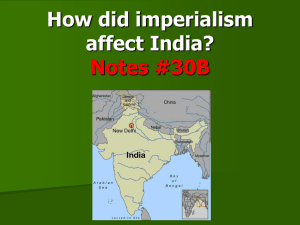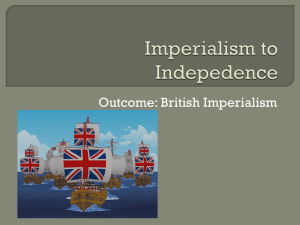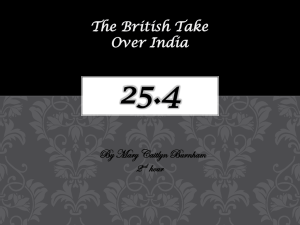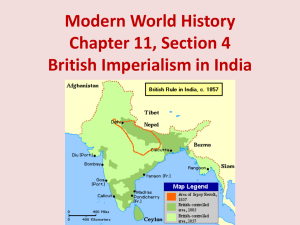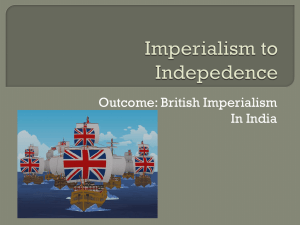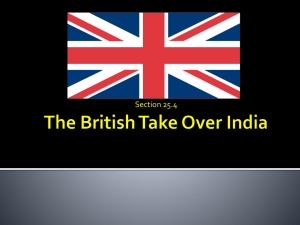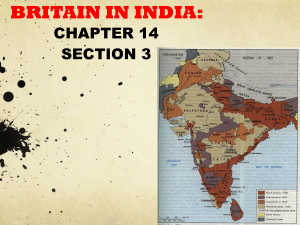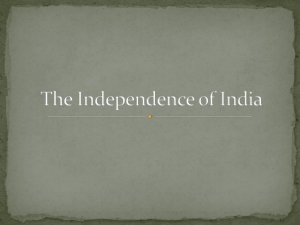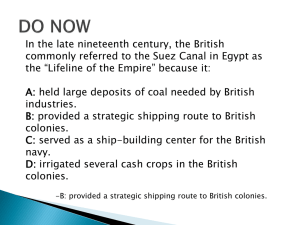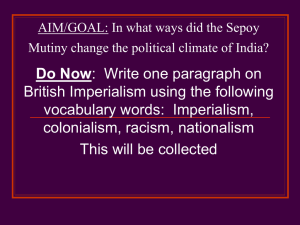Imperialism in India PPT
advertisement
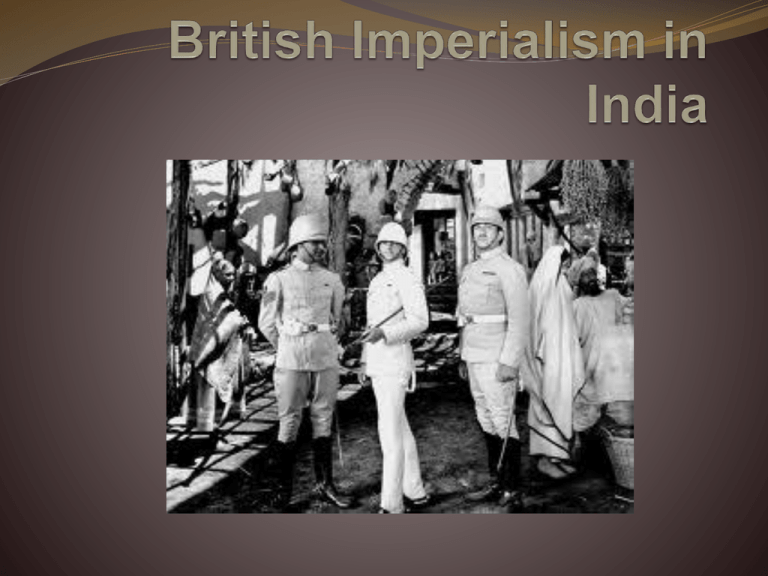
Before Colonization: The Mughal Empire In the Mughal Empire (1526-1757), Muslims were favored over the majority Hindus. Decline of the Mughals began with religious conflict between Muslims and Hindus and resulted in infighting and a divided empire. Muslims were the majority in the Northwest (modern Pakistan) and Northeast (modern Bangladesh). Many cities and some villages were mixed. End of Mughal Rule 1600s, the British East India Company (BEIC) established trading posts at Bombay (Mumbai), Madras (Chennai), and Calcutta. At first, India’s ruling Mughal Empire kept European traders under control, but already weakened by civil war and misrule few, Indians wished to defend it. By 1707, however, the Mughal Empire was collapsing. Dozens of small states, each headed by a ruler or maharajah, broke away from Mughal control. British East India Company This private profit-seeking corporation was allowed by the British government to rule India by itself through Company Rule in which the British government allowed it to act as representatives of the British and make laws as it saw fit in the areas of India it controlled. Gained control after a decisive victory at the Battle of Plassey in 1757 Worked with compliant Indian leaders to get rich trading India’s cotton, silk, indigo dye, salt, tea and opium. Company Rule India’s resources were needed to meet the worldwide demand for cheap, washable, lightweight fabrics for clothing and furnishings. This made India’s riches an irresistible target. Seeking only profit and control, (but mostly profit) the BEIC forced many Indians to grow in-demand non-food crops including the opium sent to China. Sharing none of the profits, many parts of India under the BEIC’s control faced intermittent starvation with too few farms producing food. The British Empire, however, grew incredibly rich. The Sepoys The East India Company even had its own army, led by British officers and staffed by native Indians called sepoys. Made up of Hindu Kshatriyas, Muslims and Sikhs (a north-central Indian religious minority), enough willing and loyal recruits were found to allow the British to control all the parts of India they desired. How could a few boatloads…? Second-class citizens in their own country and impoverished by the profitseeking BEIC, Indians failed to unite to kick out the British for the following reasons: Political leaders were benefiting from British trade and support, and saw benefits to modernization, The British possessed far superior weaponry, Enough Indians were willing to be hired as sepoy soldiers to defend the British, With Mughal decline preceding the arrival of the British, India was divided into small, rival kingdoms, Rivalries between Muslims and Hindus (with Hindus resenting centuries of Mulsim rule) prevented uniting to face the common enemy, The Caste System made uniting for a common cause difficult, Agent of Change: The Sepoy Mutiny In the 1850s, the colonized Indians made their first large-scale rebellion against the colonizers, led by many sepoys who turned against their British commanders. The immediate spark to the violence was resentment against being insensitively forced to use grease from the sacred cow for Hindus, and from “unclean” pigs for Muslims. The underlying cause, of course, was anger at being treated as second-class citizens in their own homeland and the British taking India’s wealth. Agent of Change: The Sepoy Mutiny Some areas stayed loyal to Britain, but the fighting Was fierce with revenge killings and atrocities against civilians, women and children by both sides. Agent of Change: The Sepoy Mutiny The British managed to keep order, but the Sepoy Mutiny showed that Company Rule could not protect British investments in India, so the British government took over control of its Indian colonies in 1858, beginning a near century of Direct Rule. For this to work, thousands of British people flocked to India to increase their presence and to build the railroads, telegraph lines and other infrastructure needed for long-term rule over hundreds of millions of Indians. Instead of driving the British out, the Sepoy Mutiny caused a massive increase of the British presence in India. (Some) Indians Brought on Board Needing a compliant workforce for such a large colony, the British began to educate wealthy and high-caste Indians to get them to adopt both the English language and British customs. The results were many Indians aiding in colonial rule, and the creation of favored Indian elites who could “act like gentlemen”. Beginnings of Indian Nationalism The new Indian middle classes slowly grew tired of the injustice of British rule, The new nationalists wrote in both English and their regional languages and turned to aspects of Indian tradition, especially Hinduism, as a rallying ground for national pride (although Muslims and the lower castes were generally excluded). 1885 – a large group of these new Indian nationalists founded the Indian National Congress (INC) to pressure colonial leaders for more rights and greater self-rule and independence. Positive Effects of Colonial Rule Railroads (the third-largest network in the world at the time) enabled India to develop a modern economy and connected regions, A modern road network, telephone and telegraph lines, dams, bridges, and irrigation canals were created, Sanitation and public health improved. Schools and colleges were founded, and literacy increased. British troops cleared central India of bandits End to local warfare among competing local rulers. Negative Impact for India British held most of the political and economic power, Profitable industries such as cotton, salt, construction, tea, etc. were firmly controlled by the British. conversion to cash crops reduced food production, causing famines in the late 1800s, Loss of cultural practices and language, Divisions between “Anglicized” elites and traditional Indians, Humiliation of being “inferior” in one’s own home. What did the British get? Control over raw materials, especially cotton, to ports for shipment to England, To bring manufactured goods from England for sale in an expanding Indian market, Insanely rich, Spread of British language, customs, and religion, Theft of many artworks and cultural treasures – sculpture, paintings and other Indian artifacts - which can be seen in many British museums today, The chance for any Englishman with half a brain to come to India, make a name for himself, get rich, and have a position of power and respect. What was negative for the British? Paid for infrastructure (roads, telephone, railroads, etc.) and development, Paid for education, Money spent on military and government in India, Needed a large military presence to maintain control, Created the class of educated Indians (the INC) who would force the British to leave India in 1947—less than a century after the beginning of Direct Rule.
